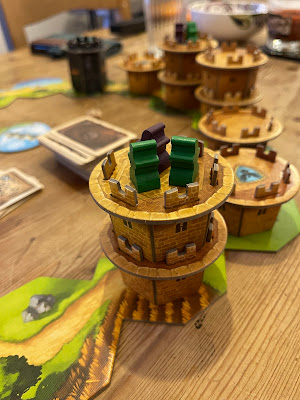We first played Wandering Towers, from Capstone Games, in December 2024 at our local tabletop convention, and I instantly fell in love with it. It perfectly balances strategy and luck, while being quick to learn and relatively quick to play to offer a very smooth and well designed experience for 1 to 6 players.
The board itself is unique in that it comprises a circular ring that the players will move their wizards and towers around. The towers are lovely, 3D folded card models that look intriguing and are great fun to play with.
The central premise of Wandering Towers is that players are attempting to get all of their wizards into a tower named Ravenskeep and fill all of their potion bottles while doing so. As soon as one player satisfies both of these win conditions the game comes to an end. The way in which players move their wizards around the board is by playing action cards that either move their wizard meeples, or the towers they stand upon. When towers land on the same space they stack on top of each other in a very satisfying way. This stacking of towers not only allows players to steal mana from wizards and therefore fill potion bottles, but it also provides an additional difficulty and is becomes increasingly difficult to keep track of where all of your wizards are, in the classic "ball under a cup" style. Whenever a wizard finds their way to Ravenskeep, it moves around the board, creating an almost constantly moving target. This element of chaos keeps all players on their toes and never lets anyone get too comfortable with their strategy.
The gameplay is smooth with very little downtime. Each turn, players will play two action cards, or discard their entire hand and move a tower of their choice, clockwise around the board. As they begin to fill their potion bottles there is a risk-reward mechanic where these can be spent to cast spells that unlock further opportunities to move wizards and towers clockwise or anti-clockwise around the board. These spells are chosen at random at the start of the game from those available in the box, and the instructions indicate that the more spells you make available, the more strategic the game becomes. However, I would suggest that rather than strategy, these spells inject a satisfying amount of chaos as it becomes harder to predict what each player is able to do on their turn.
While the theme of the game is charming, the core mechanic and purpose is abstract enough that the theme never gets in the way if magic and wizards are not your thing. You could easily strip the wizarding theme from the game entirely and it wouldn't lose anything from the enjoyment. That being said, the artwork is charming and definitely draws the eye.
Since first playing it at the tabletop convention, I have since picked up a copy of the game and it has made it to the table a number of times and never fails to entertain. Designers Michael Kiesling and Wolfgang Kramer have delivered to us a real tabletop staple that deserves as much space as other modern classics.



.jpg)
No comments:
Post a Comment